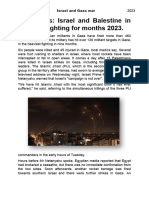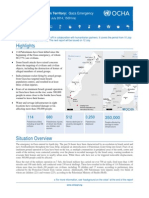11 Days, 4,340 Rockets and 261 Dead The IsraelGaza Fighting in Numbers
11 Days, 4,340 Rockets and 261 Dead The IsraelGaza Fighting in Numbers
Uploaded by
Muhammad Harieth ZainiCopyright:
Available Formats
11 Days, 4,340 Rockets and 261 Dead The IsraelGaza Fighting in Numbers
11 Days, 4,340 Rockets and 261 Dead The IsraelGaza Fighting in Numbers
Uploaded by
Muhammad Harieth ZainiOriginal Title
Copyright
Available Formats
Share this document
Did you find this document useful?
Is this content inappropriate?
Copyright:
Available Formats
11 Days, 4,340 Rockets and 261 Dead The IsraelGaza Fighting in Numbers
11 Days, 4,340 Rockets and 261 Dead The IsraelGaza Fighting in Numbers
Uploaded by
Muhammad Harieth ZainiCopyright:
Available Formats
11 days, 4,340 rockets and 261 dead: The Israel-
Gaza fighting in numbers
According to UN humanitarian office, at least 129 out of 248
people killed in Gaza were civilians and 1,042 housing and
commercial units were severely damaged
Sam Sokol |
May 23, 2021 | 9:28 PM
|
6
The fighting between Israel and Hamas this month saw the Israel Defense
Forces attack more than 1,500 targets and Palestinian militant groups launch
more than 4,300 rockets at Israel, while hundreds were killed, thousands
injured and hundreds of millions of dollars of property and infrastructure was
estimated damaged or destroyed.
The latest round of fighting began after Israel refused to comply with a
Hamas ultimatum to withdraw its forces from the East Jerusalem
neighborhood of Sheikh Jarrah and the Temple Mount by 6 P.M. on May 10,
following weeks of increasingly violent clashes between Jews and Palestinians
in Jerusalem in which hundreds were wounded.
The flare-up was by far the worst since the 2014 Gaza war, with the Tel Aviv
area seeing the heaviest rocket attack in its history, and lasted from May 10
until a cease-fire came into force on May 21. During the course of the conflict,
“air raid sirens sounded 389 times” in Ashkelon alone, the military said.
According to the army, over 11 days of fighting, approximately 4,340 rockets
were fired into Israeli territory, 640 of which fell short and impacted within
the Gaza Strip. The army also claimed a 90% success rate for the Iron Dome
missile defense system.
However, with an average of nearly 400 rockets being launched per day, even
Iron Dome was unable to prevent all of them from getting through and 13
civilians were killed, either directly from the rockets or from injuries
sustained while running for shelter. Two of them, five-year old Ido Avigal and
16-year old Nadine Awad, were children and three were foreign workers. A
soldier was also killed when an anti-tank missile fired from the Gaza Strip hit
his jeep. This toll does not include Arabs and Jews killed in clashes within
Israel.
Several of those killed, including a disabled cancer patient living in a shack
and a father and daughter from an unrecognized village, did not have access
to bomb shelters. According to a 2018 state comptroller report, nearly half of
Israel’s non-Jewish population, some 550,000 people, have no access to
shelters or protected spaces in the event of hostilities.
In a first, the Iron Dome system also intercepted several armed drones
launched from the Gaza Strip as well as an attack by a Hamas cell that
intended to use an underwater drone to disable Israel Navy ships.
According to the Israel Tax Authority, Israelis filed 3,424 claims of
compensation for property damage sustained during the fighting and 1,724
for damage to motor vehicles. This includes 228 claims of damage to property
in Ashdod, 792 in Ashkelon, 29 in Be'er Sheva, 77 in Sderot, 227 in Ramat
Gan, 182 in Petah Tikva, 188 in Holon and 77 in Tel Aviv.
In a tweet, the military stated that during the course of Operation Guardian of
the Walls, it hit over 1,500 “terror targets” in Gaza, including 675 “rocket-
launching capabilities damaged” and more than 200 “terrorists neutralized.”
Over 60 miles of Hamas’ so-called metro underground tunnel network was
also destroyed, it said.
The damage extended beyond Hamas and Islamic Jihad rocket sites,
however, and Israel has come under harsh criticism for its choice of targets as
well as the operation’s body count, which has continued to rise since fighting
ended.
Among the buildings destroyed or damaged by Israeli forces were several
high-rise towers that housed media outlets, including one which served as
military headquarters of the Associated Press’ Gaza bureau, which the IDF
said “contained military assets belonging to Hamas military intelligence.”
In response, Reporters Without Borders issued a statementcalling on the
International Criminal Court’s prosecutor “to determine whether these
airstrikes constitute war crimes.”
While no proof of Israeli assertions was shared with the media, senior Israeli
defense officials were reported to have passed on classified intelligence to
Pentagon officials about Hamas military activity in the building.
According to the United Nations Office for the Coordination of Humanitarian
Affairs (UNOCHA), 1,042 housing and commercial units in 258 buildings
were destroyed in Gaza and 769 units were severely damaged. Fifty-three
educational facilities were also damaged, as were six hospitals and 11 clinics.
“The hostilities have also caused serious damage to vital civilian
infrastructure in Gaza, affecting water, sanitation and hygiene services for
hundreds of thousands of people,” the UN agency said, noting that around
800,000 people in the coastal enclave lacked “regular access to safe piped
water.”
“Electrical power shortages and the damage to the Gaza Ministry of Health
Central Laboratory, which processes COVID-19 tests, hinder health-care
provision at dozens of centers throughout Gaza,” it added, putting current
electrical service availability at five hours a day.
UNRWA spokesman Adnan Abu Husna told Haaretz last week that the
shutdown of Gaza’s coronavirus testing lab would make it more difficult to
root out the pandemic. So far, only some 39,000 of Gaza’s 2 million
inhabitants have been vaccinated.
“People who fear that an F-16 is going to drop bombs won’t get excited about
the coronavirus,” he said, adding that anyone in Gaza can see that no steps
are being taken to fight the virus. “Nobody goes around with a mask and
people gather at funerals. The fear is that missiles will fall or the ground will
shake.”
According to UNOCHA, at least 129 out of the 248 people killed in Gaza were
civilians, 66 of whom were children. Six hundred and ten children, 398
women and 940 men were wounded during the fighting. Prior to the cease-
fire, when people started returning home, there were 71,000 internally
displaced persons sheltering in UNRWA schools and 25,000 staying with
host families within the Gaza Strip.
While most returned home after the cease-fire was announced, “about 1,000
people whose homes were destroyed or severely damaged still remain” in
UNRWA shelters, UNOCHA said.
Last Wednesday, Hamas’ information office estimated that direct material
damage to infrastructure and buildings in the Gaza Strip totaled about a
quarter of a billion dollars, with some $92 million dollars of damage was
done to residential housing and the offices of various non-governmental
organizations throughout the Strip.
On Friday, the United Nations announced that it was contributing $22.5
million “towards the response to rising humanitarian needs in Gaza.”
You might also like
- The Judas Goats: The Enemy WithinDocument378 pagesThe Judas Goats: The Enemy WithinTruth Spreader96% (28)
- Israel The Will To PrevailDocument15 pagesIsrael The Will To PrevailMacmillan PublishersNo ratings yet
- Jawad Botmeh's 2006 Masters Thesis, 'Civil Resistance in Palestine: The Village of Battir in 1948'.Document47 pagesJawad Botmeh's 2006 Masters Thesis, 'Civil Resistance in Palestine: The Village of Battir in 1948'.Benjamin RosenzweigNo ratings yet
- Hostilities in Gaza, UN Situation Report As of 21 July 2014Document7 pagesHostilities in Gaza, UN Situation Report As of 21 July 2014Haitham SabbahNo ratings yet
- BackgroundDocument1 pageBackgroundMuhammad AhmadNo ratings yet
- KosongDocument2 pagesKosongembarrsrylestariiNo ratings yet
- Assaultsongaza Chap9Document11 pagesAssaultsongaza Chap9api-280298568No ratings yet
- Hostilities in Gaza, UN Situation Report As of 05 Aug 2014Document5 pagesHostilities in Gaza, UN Situation Report As of 05 Aug 2014Haitham SabbahNo ratings yet
- Gaza Ceasefire Talks Hit Stumbling Block, Mediator Qatar SaysDocument5 pagesGaza Ceasefire Talks Hit Stumbling Block, Mediator Qatar SaysproducaocpmNo ratings yet
- Assylum Seekers ArticlesDocument16 pagesAssylum Seekers Articlesstorylover08No ratings yet
- PPSC Doze 3Document1 pagePPSC Doze 3Asma BilalNo ratings yet
- Articles of Reading SkillsDocument10 pagesArticles of Reading Skillsfarid.22016No ratings yet
- Hostilities in Gaza, UN Situation Report As of 23 July 2014Document9 pagesHostilities in Gaza, UN Situation Report As of 23 July 2014Haitham SabbahNo ratings yet
- Corpus 1 - CNNDocument24 pagesCorpus 1 - CNNsajedahalghoulNo ratings yet
- Israel's BombardmentDocument90 pagesIsrael's BombardmentZannatul FerdausNo ratings yet
- IsrarelDocument3 pagesIsrarelalanwalkerjoin4756No ratings yet
- Hostilities in Gaza and Israel, UN Situation Report As of 11 July 2014Document5 pagesHostilities in Gaza and Israel, UN Situation Report As of 11 July 2014Haitham SabbahNo ratings yet
- 01-17-09 Consortiumnews-Is Israel's Gaza War A New War Crime by Dennis BernsteinDocument3 pages01-17-09 Consortiumnews-Is Israel's Gaza War A New War Crime by Dennis BernsteinMark WelkieNo ratings yet
- Israel-Gaza Conflict Hamas Launches Surprise AttDocument1 pageIsrael-Gaza Conflict Hamas Launches Surprise AttAdelaide NcubeNo ratings yet
- Operation Pillar of Defense was an eight 100Document3 pagesOperation Pillar of Defense was an eight 100setlalethembaNo ratings yet
- Hostilities in Gaza, UN Situation Report As of 30 July 2014Document9 pagesHostilities in Gaza, UN Situation Report As of 30 July 2014Haitham SabbahNo ratings yet
- Highlights: Occupied Palestinian TerritoryDocument7 pagesHighlights: Occupied Palestinian TerritorychanvierNo ratings yet
- Current EventDocument2 pagesCurrent Eventhalima akterNo ratings yet
- Israel-Gaza Violence: The Conflict Explained: A 100-Year-Old IssueDocument7 pagesIsrael-Gaza Violence: The Conflict Explained: A 100-Year-Old IssueJolancr MarianoNo ratings yet
- Israeli-Palestinian WarDocument10 pagesIsraeli-Palestinian WarninjaindenachtNo ratings yet
- Hostilities in Gaza and Israel, UN Situation Report As of 15 July 2014Document7 pagesHostilities in Gaza and Israel, UN Situation Report As of 15 July 2014Haitham SabbahNo ratings yet
- Israel Vs PalestineDocument1 pageIsrael Vs PalestineDisha ChauhanNo ratings yet
- Operation Cast Lead - Dox1Document2 pagesOperation Cast Lead - Dox1Madaras ShoppingNo ratings yet
- Current AffairsDocument30 pagesCurrent AffairsSajjal NoorNo ratings yet
- Israel Battles Hamas Near Another Gaza Hospital Sheltering ThousandsDocument4 pagesIsrael Battles Hamas Near Another Gaza Hospital Sheltering ThousandsAmbar SanchezNo ratings yet
- Ochahu 16 31mayDocument4 pagesOchahu 16 31mayDacoNo ratings yet
- Israel's War On Gaza Live Rafah Bombarded As Israel Plans Ground Assault Israel War On Gaza News Al JazeeraDocument1 pageIsrael's War On Gaza Live Rafah Bombarded As Israel Plans Ground Assault Israel War On Gaza News Al JazeeraNianda KhairunnisaNo ratings yet
- Israel-Gaza Violence: The Conflict Explained: A 100-Year-Old Issue ANGELYNE VALDEZDocument8 pagesIsrael-Gaza Violence: The Conflict Explained: A 100-Year-Old Issue ANGELYNE VALDEZJolancr MarianoNo ratings yet
- Isreal Palestine WarDocument3 pagesIsreal Palestine Warsuliti2010No ratings yet
- Legal Technique BrieferDocument7 pagesLegal Technique BrieferPatrick Alvin AlcantaraNo ratings yet
- Land, Sea and Air Assault On Israel Global Spotlight Unprecedented Attack HostageDocument3 pagesLand, Sea and Air Assault On Israel Global Spotlight Unprecedented Attack Hostageypdfc7pj7fNo ratings yet
- Armed Men Cross Egyptian Border, Kill 8 IsraelisDocument3 pagesArmed Men Cross Egyptian Border, Kill 8 IsraelisKit StarNo ratings yet
- How The Hamas Attack Unfolded Consequences and The Collapse of The U.S Led Rules Based World Order by Mahad SamijaDocument22 pagesHow The Hamas Attack Unfolded Consequences and The Collapse of The U.S Led Rules Based World Order by Mahad SamijazaranbilalNo ratings yet
- Israeli-Palestinian Conflict - Global Conflict TrackerDocument8 pagesIsraeli-Palestinian Conflict - Global Conflict TrackerMehar WaliNo ratings yet
- Civilians in Gaza Are Legitimate TargetsDocument3 pagesCivilians in Gaza Are Legitimate TargetsAlex SmithNo ratings yet
- Vox Report On Iriral and Iran - Ocutuber Missicle AttackDocument9 pagesVox Report On Iriral and Iran - Ocutuber Missicle AttackDeepanshu KashyapNo ratings yet
- Tabassum - Houthis Attack On Red SeaDocument6 pagesTabassum - Houthis Attack On Red Seasanchitha bmNo ratings yet
- Ochahu 17feb-13marchDocument5 pagesOchahu 17feb-13marchDacoNo ratings yet
- From Displacement To Desperation: Tracing The Trajectory of Nakba To GazaDocument4 pagesFrom Displacement To Desperation: Tracing The Trajectory of Nakba To GazaElif TugtekinNo ratings yet
- Hostilities in Gaza, UN Situation Report As of 31 July 2014Document7 pagesHostilities in Gaza, UN Situation Report As of 31 July 2014Haitham SabbahNo ratings yet
- English HomeworkDocument5 pagesEnglish HomeworkcryanrosaNo ratings yet
- IsrailiDocument5 pagesIsrailimayank1745No ratings yet
- An Israeli Attack Targeting The Hamas Military Commander Kills at Least 90 in SoDocument5 pagesAn Israeli Attack Targeting The Hamas Military Commander Kills at Least 90 in SoncncnfnnfnddnndnrNo ratings yet
- Hezbollah Drone Strike in Central Israel Wounds More Than 60 People Milford MercuryDocument1 pageHezbollah Drone Strike in Central Israel Wounds More Than 60 People Milford Mercurysfx2gwhkpqNo ratings yet
- Ocha Opt Protection of Civilians Weekly Report 2013 03 08 EnglishDocument4 pagesOcha Opt Protection of Civilians Weekly Report 2013 03 08 Englishapi-206980209No ratings yet
- Fears of Escalation After Flurry of AttacksDocument4 pagesFears of Escalation After Flurry of AttacksproducaocpmNo ratings yet
- Hostilities in Gaza, UN Situation Report As of 27 July 2014editDocument8 pagesHostilities in Gaza, UN Situation Report As of 27 July 2014editHaitham SabbahNo ratings yet
- Gaza ArticleDocument2 pagesGaza ArticleJohnPapaspanosNo ratings yet
- Israel-Hamas War Live Israeli Tanks Push Deeper Into Khan Younis Israel-Palestine Conflict News Al JazeeraDocument1 pageIsrael-Hamas War Live Israeli Tanks Push Deeper Into Khan Younis Israel-Palestine Conflict News Al JazeerawandaslawyerNo ratings yet
- Pope Rewrites Catholic History: The Trumpet Weekly The Trumpet WeeklyDocument12 pagesPope Rewrites Catholic History: The Trumpet Weekly The Trumpet Weeklywaqar2010No ratings yet
- Ocha Occupied Palestinian Territory: HumanitarianDocument4 pagesOcha Occupied Palestinian Territory: Humanitarianaleksandar_djur1460No ratings yet
- Nonfiction Writing 152 GuideDocument3 pagesNonfiction Writing 152 Guideaxeljafet6No ratings yet
- Artikel Inggris BaqiDocument5 pagesArtikel Inggris Baqisdn dukuhduaNo ratings yet
- 18 April 2024ar-W1 aprrilPS OfficeDocument34 pages18 April 2024ar-W1 aprrilPS OfficebeneccditatrixiNo ratings yet
- Israel-Hamas War Live Israeli Military Pushes Deeper Into Southern Gaza As UN Warns Even More Hellish Scenario' Looms IsraelDocument1 pageIsrael-Hamas War Live Israeli Military Pushes Deeper Into Southern Gaza As UN Warns Even More Hellish Scenario' Looms Israeladityamenon593No ratings yet
- Toibas Term PaperDocument7 pagesToibas Term Paperrukhsar bhattiNo ratings yet
- Mode of CommencementDocument28 pagesMode of CommencementMuhammad Harieth ZainiNo ratings yet
- Service of Originating ProcessDocument30 pagesService of Originating ProcessMuhammad Harieth ZainiNo ratings yet
- Prelim Issues - Before Filing A Case - HizriDocument18 pagesPrelim Issues - Before Filing A Case - HizriMuhammad Harieth ZainiNo ratings yet
- Intro To Sources of Civil Procedure Law - HizriDocument28 pagesIntro To Sources of Civil Procedure Law - HizriMuhammad Harieth ZainiNo ratings yet
- Politics and Government in Israel The Maturation of A Modern State Gregory Mahler Download PDFDocument45 pagesPolitics and Government in Israel The Maturation of A Modern State Gregory Mahler Download PDFaubrantebri100% (3)
- The Jewish HeraldDocument44 pagesThe Jewish HeraldTheresa MyrillNo ratings yet
- Eastern Mediterranean Geopolitical Review 2015Document75 pagesEastern Mediterranean Geopolitical Review 2015ncharalaNo ratings yet
- Ali KhanDocument388 pagesAli KhanAlma SlatkovicNo ratings yet
- Acting The Landlord: Israel's Policy in Area C, The West BankDocument111 pagesActing The Landlord: Israel's Policy in Area C, The West Bank972 MagazineNo ratings yet
- Middle East InstituteDocument23 pagesMiddle East InstituterinaldofrancescaNo ratings yet
- Acept 2014 - Ilc Hmp-Ugm - Edisi RevisiDocument35 pagesAcept 2014 - Ilc Hmp-Ugm - Edisi RevisiFathimah Nurfithri Hashifa100% (2)
- Sephardi An Exile WithinDocument21 pagesSephardi An Exile WithinErick StolzNo ratings yet
- Jewish Standard, February 5, 2016Document52 pagesJewish Standard, February 5, 2016New Jersey Jewish StandardNo ratings yet
- AZOULAY Potential HistoryDocument28 pagesAZOULAY Potential HistoryBiagio D'AngeloNo ratings yet
- CSD PRICELIST DEC 2024Document1 pageCSD PRICELIST DEC 2024skyedp2No ratings yet
- Student Guide 2019Document45 pagesStudent Guide 2019Thien LeNo ratings yet
- The Meaning and Context of Tikkun OlamDocument8 pagesThe Meaning and Context of Tikkun OlamThe Reut InstituteNo ratings yet
- The Hidden War Prophecy in Psalm 108 Connected To 2008 and BeyondDocument5 pagesThe Hidden War Prophecy in Psalm 108 Connected To 2008 and BeyondHelena LehmanNo ratings yet
- Untitled DocumentDocument3 pagesUntitled DocumentButterfly HuexNo ratings yet
- Zionist Media Domination:: The Jewish Suicide Bomber Thatt You Never Heard OffDocument9 pagesZionist Media Domination:: The Jewish Suicide Bomber Thatt You Never Heard OffResearchingPub0% (1)
- North Jersey Jewish StandardDocument64 pagesNorth Jersey Jewish StandardNew Jersey Jewish StandardNo ratings yet
- Chronology of The Occupation Regime 1967Document32 pagesChronology of The Occupation Regime 1967Youssef MnailiNo ratings yet
- Final Asian StudiesDocument9 pagesFinal Asian StudiesRazel G. TaquisoNo ratings yet
- Final Test 2023.1Document4 pagesFinal Test 2023.1laraaugustin11No ratings yet
- 4th Edition of Indo-Pacific InsightsDocument5 pages4th Edition of Indo-Pacific InsightsNihad NowsherNo ratings yet
- Israel Gaza WarDocument3 pagesIsrael Gaza WarhjNo ratings yet
- Characteristics of IsraelDocument29 pagesCharacteristics of Israeleye-no100% (1)
- Handelman 2012Document12 pagesHandelman 2012kartika prayogiNo ratings yet
- The Arab ObserverDocument5 pagesThe Arab ObserverShantanu Shenai100% (1)
- The Christianisation of Rural Palestine During Late AntiquityDocument21 pagesThe Christianisation of Rural Palestine During Late AntiquityMelangell Shirley Roe-Stevens SmithNo ratings yet
- Corrie Trial PR March15 enDocument2 pagesCorrie Trial PR March15 enBren-RNo ratings yet





























































































